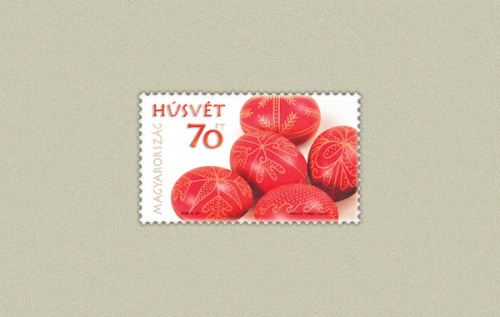
1. MAGYAR - HÚSVÉT 2008 - Bélyeg rendelési kód: 2008 év bélyegei kompletten
2. ENGLISH - EASTER 2008 - Order code of the stamp: 2008 Year stamps complete
3. GERMAN - Ostern 2008 - Die Bestellnummer Der Marke: 2008 Jahr Briefmarken komplett
1. MAGYAR - HÚSVÉT 2008
A Magyar Posta immár hagyományszerűen postabélyeg kibocsátásával köszönti a húsvétot.
A kereszténység egyik legnagyobb ünnepéhez népszokások, népi hagyományok is kapcsolódnak, közülük az egyik legjellegzetesebb a tojásírása és ajándékozása. A tojás a belőle kikelő madárral a feltámadó Krisztus jelképe.
Az ünnepi képeslapok és levelek postára adásához készült forgalmi bélyegen Mosonyi Csabáné magyar kézműves remek díjas tojásíró népi iparművész alkotásai láthatók. Az alkalmi boríték grafikáján a tojásírás pillanata tűnik elő, a bélyegző grafikáján tojás díszítő motívum szerepel.
Mosonyi Csabáné így vall tevékenységéről: „Anyai nagymamámtól örököltem a hagyományt, a viasszal, gicával történő tojásírás technikáját és a baranyai kis falu, Kékesd mintakincsét. Így előbb tanultam meg a tojásírás, mint a betűvetés tudományát. Csak akkor döbbentem rá, hogy kincset örököltem, amikor először, a Pécsi Néprajzi Múzeumban láttam viszont nagymama tojásait…
Csaknem 40 éve őrzöm és évről évre csiszolom a magyar népművészet ezen ágának, a tojásírásnak a hagyományát. Ma már nemcsak a húsvéti ünnepkörre készülve készítem a hímeseket, hanem egész évre kiterjedő, folyamatos, szisztematikus tevékenységemmé vált. Ez életem elválaszthatatlan része, boldoggá ez által válok."
Megjelenési időpont: 2008. február 27.
Forrás: Philatelia Hungarica Kft., Magyar Posta
2. ENGLISH - EASTER 2008
As is traditional Magyar Posta is celebrating Easter with the issue of a stamp.
Folk customs and folk traditions are also linked to this important Christian holiday, among these one of the most characteristic is the custom of egg drawing and the giving of eggs. The egg with the bird hatching from it is a symbol of the resurrected Christ.
The postage stamp made for the posting of Easter postcards and letters shows the works of Hungarian craftsmanship prize-winning egg drawing applied artist Mrs. Csaba Mosonyi. The graphic design of the first day cover depicts a moment from the process of egg drawing, and the cancellation stamp graphic includes an egg drawing motif.
Mrs. Csaba Mosonyi says the following of her activities: “I inherited this tradition, the egg drawing technique using wax and special pen and the treasure of patterns of the tiny village in Barany county, Kékesd from my maternal grandmother. In this way I learnt the craft of egg drawing before I could write.
It was only when I saw my grandmother’s eggs again in the Pécs Museum of Ethnology that I realised I had inherited a treasure… For nearly 40 years I have been preserving and polishing from year to year this branch of Hungarian folk art, the tradition of egg drawing. Now I do not only make these decorated eggs for the Easter celebrations, but it has become a continuous, systematic activity spread over the entire year. It is an inseparable part of my life, this is what makes me happy.”
Date of issue: 27 February 2008
3. GERMAN - Ostern 2008
Die Ungarische Post hat jetzt eine Geschichte der Ausstellung von Porto Ostern begrüßt.
Das Christentum ist eine der größten Festival der Folk-Zoll-, Folk-Traditionen verbunden sind, von denen die meisten das Ei Schreiben und Spenden. Der Vogel Bruteiern aus sie zu einem Symbol des auferstandenen Christus.
Die formale Einreichung von Postkarten und Briefe verschickt Registrierung Aufkleber gemacht Mosonyi Csaba ungarischen Volkskunst große tojásíró gewinnen Künstler arbeitet, werden angezeigt. Umschlag des Eies schriftlich gelegentlich Moment der Grafiken angezeigt, den Stempel Grafiken Eier in der dekorativen Muster.
Mosonyi Csaba Aktivitäten wie Vall: "Großmutter mütterlicherseits vererbt der Tradition der Wachs, das Ei Gica schriftlich Technik und einem kleinen Dorf im Komitat Baranya und blauen Mustern. So, der erste Ei schriftlich betűvetés Wissenschaft gelernt. Kann nur realisiert werden, daß der Schatz geerbt von der ersten Zeit, das Ethnographische Museum in Pécs gesehen Eier, aber meine Großmutter ...
Vor fast 40 Jahren und hält den Boden von Jahr zu Jahr, diesen Zweig der ungarischen Volkskunst Ei schriftlich Tradition. Heute, nicht nur als Vorbereitung für die Oster-ünnepkörre die hímeseket Hersteller, sondern für das ganze Jahr, kontinuierliche, systematische tevékenységemmé werden. Dies ist ein wesentlicher Teil meines Lebens, ich werde von dieser glücklich. "










